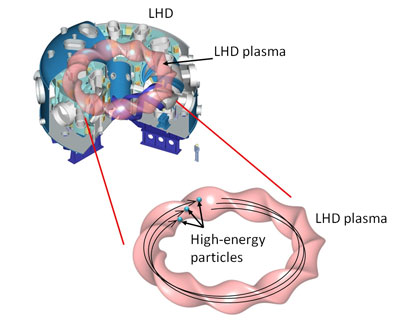HOME > Research Activities > Research Updates >
Clarifying Plasma Perturbations by High-energy Particles: Hybrid Simulations Using Particles and Fluids
We use deuterium and tritium to achieve the fusion reaction in the future. The high-energy alpha particles (helium ions) that are generated by the fusion reaction heat the plasma and bear the important role of maintaining the high temperature condition that is necessary for the fusion reaction. For that reason, prediction of the behavior of high-energy alpha particles and their control hold the key for maintaining the fusion reaction. Here, we will introduce the simulation program that was developed with the aim of predicting to a high accuracy the behavior of high-energy particles.
In considering the behavior of high-energy alpha particles, plasma perturbations become extremely important. To understand plasma as a whole, it is a fluid through which electricity passes, and it is called a magnetofluid because the magnetic field is generated through the flow of the electric current. To use water as an example, a plasma which is a magnetofluid is perturbed similar to the wave which appears on the surface of water. When the plasma perturbation period and the period when high-energy alpha particles circulate inside the plasma both match, there is the possibility that the amplitude of the perturbations will increase due to the resonance. As a result, because the high-energy alpha particles will be ejected to outside the plasma there is concern that the performance of the fusion reaction will degrade. In order to achieve fusion power generation, it is imperative to predict with high reliability the behavior and the distribution of high-energy particles where plasma perturbations are taken into account.
The National Institute for Fusion Science is aiming to achieve predictions with high reliability, and we have developed a computer program that can simultaneously simulate the state of the plasma and the movement of the high-energy particles. This simulation, because it links and calculates the fluid and the particles, is called hybrid-simulation. Now, it has become possible to jointly investigate in detail by simulation the interaction between the plasma perturbations and the high-energy particles that we had not been able to investigate in earlier methods by which the plasma and the high-energy particles had been calculated separately. Using this hybrid-simulation program, we performed a large-scale simulation on the supercomputer regarding plasma generated in the Large Helical Device (LHD). (On the LHD, because the plasma does not undergo a fusion reaction we utilize the high-energy hydrogen particles that are inside the plasma. We are conducting experiments regarding the high-energy particles and the plasma perturbations.) In results of the simulations, together with reproducing well the plasma perturbation data caused by the high-energy particles obtained from the LHD experiments, we were able to clarify detailed behaviors of perturbations that cannot be measured by experiment and to clarify interactions between perturbations and high-energy particles that amplify the perturbations.
The Hybrid-Simulation Program has already been applied to tokamak experimental devices in Japan and in the United States, and reliability has been confirmed through comparison of experimental results regarding the distribution of high-energy particles and the plasma perturbations. This time, by successful replication of the experiment in the helical-style LHD, with its more complicated structure, we achieved for the first time in the world a program that enables simulation of high-energy particles and plasma perturbations in fusion plasma experimental devices around the world. At present, using the hybrid-simulation program, beginning with the ITER project under construction in France, in Japan and abroad (the People’s Republic of China, the Republic of Korea, Germany, and other countries) simulations regarding plasma perturbations and high-energy particles are ongoing. Thus, the hybrid-simulation program, together with significantly improving the prediction accuracy of the distribution of high-energy alpha particles in future fusion reactor plasma, is greatly contributing to development in fusion research around the world.

